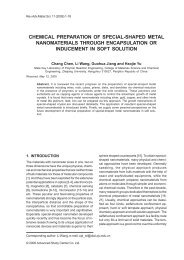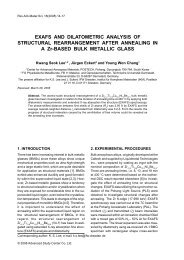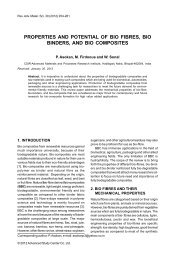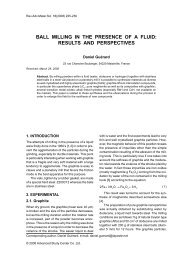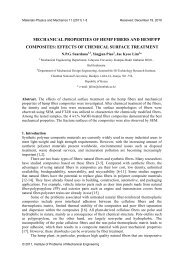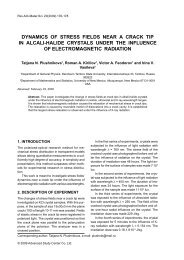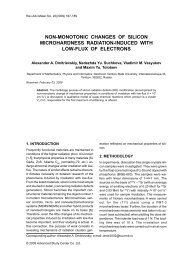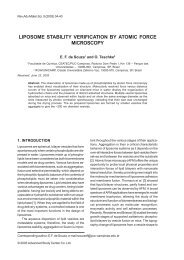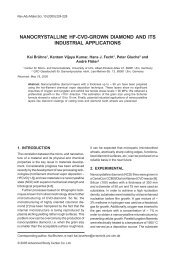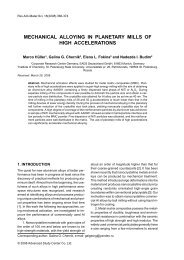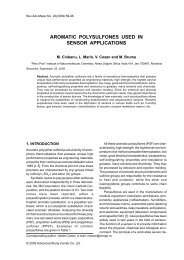surface pretreatment by phosphate conversion coatings – a review
surface pretreatment by phosphate conversion coatings – a review
surface pretreatment by phosphate conversion coatings – a review
You also want an ePaper? Increase the reach of your titles
YUMPU automatically turns print PDFs into web optimized ePapers that Google loves.
136 T.S.N. Sankara Narayanan<br />
felt way back in the 19th century and its development<br />
has gained a rapid momentum with the advent<br />
of the Bonderite process in 1929. Recently,<br />
Sankara Narayanan et al. [131] have made an overview<br />
on the acceleration of the phosphating process<br />
and justified its role on the hunting demand to reduce<br />
process time. The different means of accelerating<br />
the formation of <strong>phosphate</strong> <strong>coatings</strong> can be<br />
broadly classified as: (i) Chemical acceleration; (ii)<br />
Mechanical acceleration; and (iii) Electrochemical<br />
acceleration.<br />
3.3.1. Chemical acceleration<br />
Oxidizing substances [132,133] and metals more<br />
noble than iron such as, Cu, Ni, [19] etc., constitute<br />
the most important class of chemical accelerators.<br />
They accelerate the deposition process<br />
through different mechanisms. Oxidizing agents<br />
depolarize the cathode half-cell reaction <strong>by</strong> preventing<br />
the accumulation of hydrogen at the cathodic<br />
sites, whereas noble metal ions promote metal dissolution<br />
<strong>by</strong> providing low over-potential cathode sites<br />
<strong>by</strong> their deposition [134]. Since acceleration through<br />
depolarization is preferred to mere promotion of<br />
metal dissolution, oxidizing agents have found widespread<br />
use than metals. Moreover, they prevent the<br />
excessive build up of iron in the bath, which can be<br />
detrimental to good coating formation [25]. The most<br />
commonly employed oxidizing accelerators are nitrites,<br />
chlorates, nitrates, peroxides and organic nitro<br />
compounds either alone or in various combinations.<br />
Common combinations are nitrite-nitrate, nitrite-chlorate-nitrate<br />
and chlorate-nitrobenzene sulphonic<br />
acid. The characteristics of some of the commonly<br />
used oxidizing accelerators are given in Table 4.<br />
Some reducing agents such as alkali metal sulphites<br />
[135], hypophosphites [136], phosphites [137], formaldehyde,<br />
benzaldehyde, hydroxylamine [138], acetaldehyde<br />
oxime [139], Pyridine N-oxime [140],<br />
morpholine N-oxime [140], quinones [141], etc., have<br />
also been tried as accelerators but have not been<br />
as successful as oxidizing accelerators from the<br />
industrial point of view.<br />
3.3.2. Mechanical acceleration<br />
When a phosphating solution is sprayed forcibly on<br />
to a metal <strong>surface</strong>, <strong>coatings</strong> are formed more readily<br />
than would be <strong>by</strong> immersion in the same solution,<br />
since the former process eliminates the delay due<br />
to the diffusion of the constituents in the solution to<br />
the metal <strong>surface</strong>. The comparative kinetics of spray<br />
and dip phosphating was determined <strong>by</strong> Laukonis<br />
[142]. The resultant <strong>coatings</strong> are thin, fine-crystalline<br />
and perfectly suitable as a paint base. Other<br />
means of physical acceleration are the action of<br />
brushes and rollers [143] on the <strong>surface</strong> during processing.<br />
3.3.3. Electrochemical acceleration<br />
Several electrochemical methods of acceleration,<br />
both anodic, cathodic and pulse method have been<br />
described in literature [144-161]. Coslett recognized<br />
acceleration of the phosphating process <strong>by</strong> cathodic<br />
treatment as early as 1909 <strong>by</strong> Coslett [144]. Subsequent<br />
studies reveal that anodic methods are<br />
more appropriate and advantageous than the cathodic<br />
methods, as they promote metal dissolution<br />
as well as passivity. Zantout and Gabe [148] claim<br />
to have achieved higher coating weights of low porosity<br />
in a shorter treatment time <strong>by</strong> the application<br />
of a small current. Ravichandran et al., [157-159]<br />
established the utility of galvanic coupling of steel<br />
substrate with metals which are more noble than<br />
steel for accelerating phosphating processes. This<br />
methodology employs the galvanic corrosion principle<br />
for accelerating the metal dissolution reaction,<br />
which enables a quicker consumption of free phosphoric<br />
acid and an earlier attainment of the point of<br />
incipient precipitation, resulting in higher amount of<br />
<strong>phosphate</strong> coating formation. The application of a<br />
cathodic current to form <strong>phosphate</strong> coating on stainless<br />
steel using a calcium modified zinc phosphating<br />
bath was patented <strong>by</strong> Bjerrum et al. [160]. Sinha<br />
and Feser [161] have also studied the formation of<br />
<strong>phosphate</strong> coating on steel and stainless steel substrates<br />
<strong>by</strong> this method.<br />
These three methods of acceleration described<br />
above are widely practiced in industries; but<br />
each of them has its own merits and demerits.<br />
Though chemical accelerators (Primarily those of<br />
the oxidizing type) accelerate the phosphating process<br />
<strong>by</strong> their mere addition, their concentration in<br />
the bath is very critical to yield the desired results.<br />
Acceleration <strong>by</strong> mechanical means is limited to<br />
spray processes, which are capable of providing<br />
fresh bath solution constantly. Electrochemical<br />
methods of acceleration though capable of yielding<br />
higher deposition rate, the practical difficulty in adding<br />
‘electrics’ to the processing stage makes it less<br />
popular.



